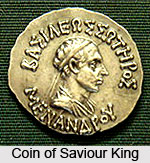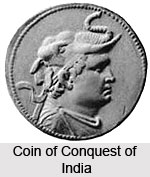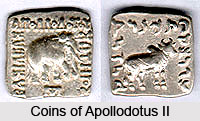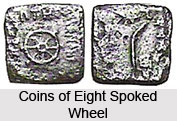 The Indo-Greek Kingdom covered various parts of the northwest and northern Indian subcontinent from 180 BCE to around 10 CE, and was ruled by a succession of more than thirty Hellenic kings who were often in conflict with each other. The kingdom was founded when the Greco-Bactrian king Demetrius, the king of Syria, who invaded India in 180BC.
The Indo-Greek Kingdom covered various parts of the northwest and northern Indian subcontinent from 180 BCE to around 10 CE, and was ruled by a succession of more than thirty Hellenic kings who were often in conflict with each other. The kingdom was founded when the Greco-Bactrian king Demetrius, the king of Syria, who invaded India in 180BC.
During the two centuries of their rule, the Indo-Greek kings combined the Greek and Indian languages and symbols, as seen on their coins, and blended ancient Greek, Hindu and Buddhist religious practices, as seen in the archaeological remains of their cities and in the indications of their support of Buddhism.
Buddhism flourished under the Indo-Greek kings, and it has been suggested, although direct evidence is lacking, that their invasion of India was intended to show their support for the Mauryan empire, which had a long history of marital alliances, treaties of friendship, and exchange of ambassadors and religious emissaries with the Greeks, and to protect the Buddhist faith from the religious persecutions of the Sungas. The city of Sirkap founded by Demetrius combines Greek and Indian influences without signs of segregation between the two cultures.
 The first Greek coins to be minted in India, those of Menander I and Appolodotus I bear the mention "Saviour king" (BASILEOS SOTHROS), a title with high value in the Greek world which indicated an important deflective victory. There were coins minted by Demetrios I, Seleukid Kings of Syria. These coins were made of silver, weighing 4.2 grams, with a Diademed head in the obverse and a Cornucopia in the reverse. This was around 162 BC.
The first Greek coins to be minted in India, those of Menander I and Appolodotus I bear the mention "Saviour king" (BASILEOS SOTHROS), a title with high value in the Greek world which indicated an important deflective victory. There were coins minted by Demetrios I, Seleukid Kings of Syria. These coins were made of silver, weighing 4.2 grams, with a Diademed head in the obverse and a Cornucopia in the reverse. This was around 162 BC.
After Bactria declared himself King in 256BC, he soon issued gold and copper coins bearing his portrait on obverse and Greek deities (prominently Zeus) on reverse.
Also, most of the coins of the Greek kings in India were bilingual, written in Greek on the front and in Pali (in the Kharoshthi script) on the back, a tremendous concession to another culture never before made in the Hellenic world.
After death of last great Mauryan King, Ashoka, India was disintegrated into many small kingdoms, which provided great opportunity for Indo-Greek kings for eastern expansion of their kingdoms.
The coins stuck by Euthydemus, Demetrius and Antimachus (weriearing kausia cap and half mocking smile) are purely Greek in style, in language and in weight and are the best examples of art applied to portraiture, anywhere in the world. These coins depict the lifelike portraits of these kings. After the so called `conquest of India`, Demetrius minted coins showing himself wearing elephant`s scalp which represent the excellent example of portrait coins of Indo-Greeks.
 Demetrius was followed by two of his generals, Apollodotus I and Menander. Both ruled different regions of North Western India. Menander, known as Milinda, has earned tremendous fame as a great ruler not only in India but also in Greek world. He was a great conqueror and ruled over large areas. His coins, which show greater variety and wider distribution than those of any other Indo-Greek ruler, are found in all of modern Afganistan, Pakistan and northwestern region of modern India. His coins were bilingual with interrupted legends on them. One example of his coin minted at Taxila has the king throwing Javelin on the obverse. The legends are in Greek, King Soter Menander while reverse shows Pallas Athene facing left with sloping shield.
Demetrius was followed by two of his generals, Apollodotus I and Menander. Both ruled different regions of North Western India. Menander, known as Milinda, has earned tremendous fame as a great ruler not only in India but also in Greek world. He was a great conqueror and ruled over large areas. His coins, which show greater variety and wider distribution than those of any other Indo-Greek ruler, are found in all of modern Afganistan, Pakistan and northwestern region of modern India. His coins were bilingual with interrupted legends on them. One example of his coin minted at Taxila has the king throwing Javelin on the obverse. The legends are in Greek, King Soter Menander while reverse shows Pallas Athene facing left with sloping shield.
From the reign of Apollodotus II, around 80 BCE, Kharoshthi letters started to be used as mintmarks on coins in combination with Greek monograms and mintmarks, suggests the participation of local technicians to the minting process. Before arrival of Indo-Greeks, local population of his newly acquired kingdom had been using rectangular/square shaped punch-marked coins for most transactions. Perhaps this fact had influenced him to issue square shaped, bilingual coinage, which can be accepted readily by local merchants. Also, to keep up with Indian tradition of punching animals like Elephant and Bull on punch-marked coin, his coins also bear these two animals. The legends on reverse are in Prakrit, written in Kharoshthi script. Incidentally, these bilingual coins of the Indo-Greeks were the key in the decipherment of the Kharoshthi script by James Prinsep (1799-1840). Kharoshthi became extinct around the 3rd century CE.
The Bactrian king Antimachus` coins depicts king wearing flat cap (kausia) sitting on prancing horse. Philoxenus kingdom consisted of Valley of Jhelum river. His coins are found only to the east of Jalalabad district.
The kings of house of Eucratides ruled in the region south of Hidu Kush and upper Kabul valley (southern half of modern Afganistan). Hermaeus belonged to this house and minted coins depicting Zeus enthroned. Hermaeus was the last Indo-Greek king. His kingdom was invaded successively by Shakas (Scythias).

Later, some Indo-Greek coins incorporate the Buddhist symbol of the eight-spoked wheel, such as those of Menander I, as well as his possible grandson Menander II. On these coins, the wheel is associated with the Greek symbols of victory, either the palm of victory, or the victory wreath handed over by the goddess Nike. This symbology has led some to conclude that Menander adopted the Buddhist mantle of a "Chakravartin" during his lifetime; lit., "one for whom the wheel of law turns," translated as "King of the Wheel" in Western texts. The ubiquitous symbol of the elephant may or may not have been associated with Buddhism. Interestingly, on some coin series of Antialcidas, the elephant holds the same relationship to Zeus and Nike as the Buddhist wheel on the coin of Menander II, tending to suggest a common meaning for both symbols. Some of the earlier coins of king Apollodotus I directly associate the elephant with Buddhist symbolism, such as the stupa hill surmounted by a star, also seen, for example on the coins of the Mauryan Empire or those of the later Kuninda kingdom.
Conversely, the bull is probably associated with Shiva, and often described in an erectile state as on the coins of Apollodotus I.
Right after the death of Menander, several Indo-Greek rulers also started to adopt on their coins the Pali title of "Dharmikasa", meaning "follower of the Dharma" (the title of the great Indian Buddhist king Ashoka was Dharmaraja "King of the Dharma"). Strato I, Zoilos I, Heliokles II, Theophilos, Peukolaos, Menander II and Archebios adopted this usage.
Altogether, the conversion of Menander I to Buddhism suggested by the Milinda Panha seems to have triggered the use of Buddhist symbolism in one form or another on the coinage of close to half of the kings who succeeded him. Especially, all the kings after Menander who are recorded to have ruled in Gandhara (apart from the little known Demetrius III) display Buddhist symbolism in one form or another. On the contrary, none of the kings whose rule was limited to Punjab did display Buddhist signs.
Agathocles issued around 180 BCE the first known bilingual coins of the Indo-Greeks. These coins were found in Ai-Khanoum, the great Greco-Bactrian city in northeastern Afghanistan, but introduce for the first time an Indian script (the Brahmi script which had been in use under the Mauryan empire), and the first known representations of Hindu deities, in a very Indian iconography:
 Krishna-Vasudeva, with his large wheel with six spokes (chakra) and conch (shanka), and his brother Sankarshan-Balarama, with his plough (hala) and pestle (masala), both early avatars of Vishnu.[30] The square coins, instead of the usual Greek round coins, also followed the Indian standard for coinage. The dancing girls on some of the coins of Agathocles and Pantaleon are also sometimes considered as representations of Subhadra, Krishna`s sister. Hindu anthropomorphic deities were never again represented in Indo-Greek coinage (although the bull on the vast quantity of subsequent coins may have symbolized Shiva, as the elephant may have symbolized Buddhism), and the Kharoshti script, derived from Aramaic, immediately replaced the Brahmi script. The general practice however of minting bilingual coins and combining Greek and Indian iconography, sometimes in the Greek and sometimes in the Indian standard continued for the next two centuries. In any case, these coins suggest the strong presence of Indian religious traditions in the northwestern Indian subcontinent at that time, and the willingness of the Greeks to acknowledge and even promote them. Artistically, they tend to indicate that the Greeks were not particularly reluctant to make representations of local deities, which has some bearing on the later emergence of the image of the Buddha in Hellenistic style.
Krishna-Vasudeva, with his large wheel with six spokes (chakra) and conch (shanka), and his brother Sankarshan-Balarama, with his plough (hala) and pestle (masala), both early avatars of Vishnu.[30] The square coins, instead of the usual Greek round coins, also followed the Indian standard for coinage. The dancing girls on some of the coins of Agathocles and Pantaleon are also sometimes considered as representations of Subhadra, Krishna`s sister. Hindu anthropomorphic deities were never again represented in Indo-Greek coinage (although the bull on the vast quantity of subsequent coins may have symbolized Shiva, as the elephant may have symbolized Buddhism), and the Kharoshti script, derived from Aramaic, immediately replaced the Brahmi script. The general practice however of minting bilingual coins and combining Greek and Indian iconography, sometimes in the Greek and sometimes in the Indian standard continued for the next two centuries. In any case, these coins suggest the strong presence of Indian religious traditions in the northwestern Indian subcontinent at that time, and the willingness of the Greeks to acknowledge and even promote them. Artistically, they tend to indicate that the Greeks were not particularly reluctant to make representations of local deities, which has some bearing on the later emergence of the image of the Buddha in Hellenistic style.
Persian culture and religion seem to have been rather influential among the Western Indo-Greeks, who, located around the Paropamisadae, lived in direct contact with the Central Asian cultural sphere and the eastern reaches of the Parthian empire. Images of the Persian Zoroastrian god Mithra appear extensively on the Indo-Greek coinage of the Western kings, as a god with a radiated phrygian cap.

This Zeus-Mithra god is also the one represented seated (with the rays around the head, and a small protrusion on the top of the head representing the cap) on many coins of Hermaeus, Antialcidas or Heliokles II, or possibly even earlier during the time of Eucratides I, on whose coins the deity is said to be the god of the city of Kapisa.
Many people of Chamba found hoard of coins (Maya) but consumed the same by selling it in the market and mostly the ancient coins being made up of silver and gold was utilized for ornaments. The numismatic collection of Bhuri Singh Museum Chamba and Himachal State Museum Shimla is not very large. If effort to collect the ancient coin is made, a number of ancient coins either lying in private collections or beneath the earth could be found. My efforts are based on Mr. Parmeshwari lal Gupta`s work in his solitary book of numismatic history of Himachal Pradesh and the catalogue of coins in Himachal State Museum, Shimla and Bhuri Singh Museum Chamba. But despite this great work, two of the Chamba found acquired by the Bhuri Singh Museum Chamba has remained unattributed, unclassified assorted coins till this date.
In numismatic History of Chamba Indo-Greek coins of 1st & 2nd Century BC finds a special mention being the largest hoards in Himachal Pradesh. These coins have been discovered in good number of quantity at two places of Lachori and Sarol of Champakpur Kingdom and District Chamba of Himachal Pradesh.






































